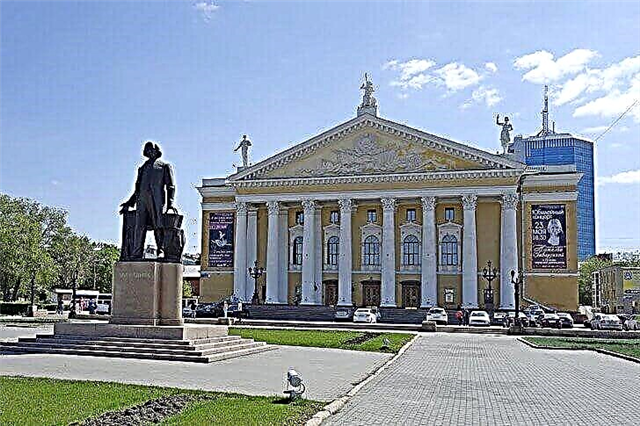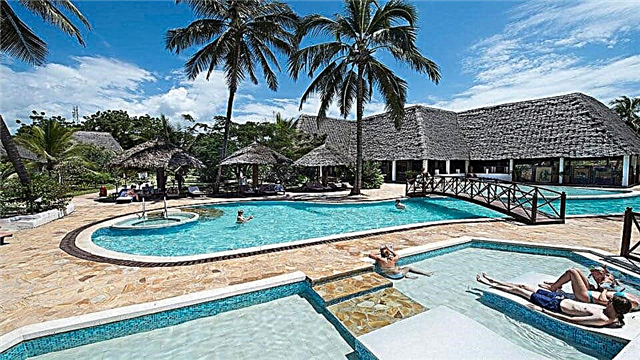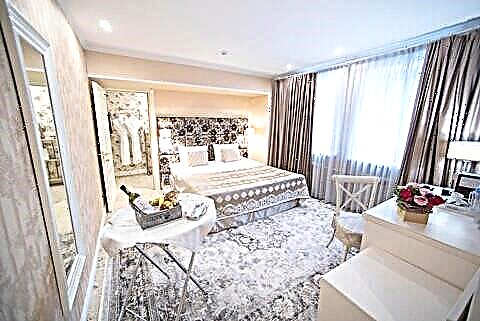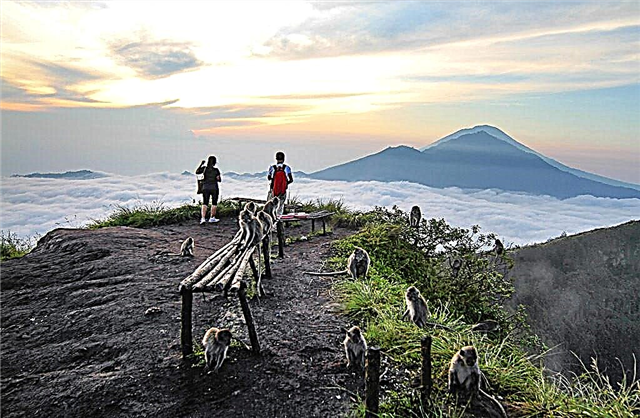Chelyabinsk is one of the largest industrial centers in Russia, a powerful smithy and a locomotive for the country's heavy metallurgy. But besides the smoking chimneys of huge enterprises, the city can show tourists its picturesque green parks, theaters with talented actors, museums with fascinating and valuable exhibits, monumental sculptures and majestic temples.
In Chelyabinsk, you can walk along the Kirov pedestrian street or the Alley of Glory, visit the grandiose exposition of the railway museum located right on the tracks, or go to the legendary ChTZ to feel the special atmosphere of the city. The Chelyabinsk monuments are also interesting, especially the conceptual monuments to the physicist Kurchatov and the Ural fairy-tale blacksmith.

The best hotels and hotels at affordable prices.
from 500 rubles / day
What to see and where to go in Chelyabinsk?
The most interesting and beautiful places for walking. Photos and a short description.
Kirovka street
A pedestrian zone that plays the role of the local Arbat. It was finally completed in the 2000s. Here you will find original city sculptures, shops, cafes and entertainment facilities - everything you need for a good rest and a pleasant walk. Also along the street there are historical mansions with interesting architecture of the early XX century and the modern business center "Chelyabinsk City".

Scarlet field
A park in the central region of Chelyabinsk, created in the 1940s and 1960s. Recently, it has been under state protection, as it has been declared a historical landmark. In the 19th century, on the site of the park, there was a square where the city fair was held. In 1905, a demonstration of workers was dispersed here with the use of weapons, as a result of which the place was named "Alay Square".

Glinka Opera and Ballet Theater
The opera stage appeared in Chelyabinsk in the 1950s. Construction of the building began in 1937 on the site of the demolished Nativity of Christ Cathedral. The building is made in a classical style with elements of Soviet constructivism. The entrance portico is supported by monumental columns, sculptural groups are placed on the roof, the upper part of the facade is decorated with a massive stucco coat of arms of the Soviet Union.

Drama Theater named after Naum Orlov
A dramatic scene founded in the 1920s. The theater building is somewhat reminiscent of an administrative building, and it could be confused with the city duma, if not for the figures of theatrical masks placed on the facade. A wide alley with a flower garden in the center leads to the entrance. In the evening, the building looks very picturesque thanks to professional lighting design. The theater is located on Revolution Square, surrounded by monumental buildings in the Stalinist Empire style.

Cinema named after A.S. Pushkin
The cinema was built in 1937. At that time, it was the only one in the entire RSFSR that had two halls. The construction of the institution was timed to coincide with the 100th anniversary of the death of A. Pushkin. Along with screenings of films, literary evenings, concerts and creative meetings were held there. The building was built in the style of Soviet constructivism. Since 2000, the cinema has been merged with the Mannequin Theater, a dramatic stage that emerged in the 1960s on the basis of a student acting studio.

Hall of chamber and organ music "Rodina"
The Concert Hall is located in a building of the mid-20th century, erected in the neoclassical style according to the project of V. Ya. Gofrat. The structure was built as a cinema and performed this function until 2002, until it came into disrepair. In 2010-2014, the building was reconstructed and re-planned in accordance with the canons of the classical style, but using modern materials. During the restoration, many of the lost elements were restored.

Drama Chamber Theater
The theater scene is the youngest in the city - it was founded in the late 1980s by a group of actors from the Theater of the Young Spectator. From the very first performances, she attracted the attention of the public with an interesting manner of performance, and strict critics praised the performances and skill of the troupe. Until 1991, the stage did not have its own permanent building, so different venues had to be rented.

Historical Museum of the South Urals
The museum was opened in 1923, at the moment there are more than 250 thousand exhibits in its funds. The collection consists of permanent exhibitions: archaeological, historical, ethnographic, natural and decorative and applied. Since 2006, exhibitions have been housed in a modern building equipped with multimedia equipment, which allows diversifying the classic presentation of material.

Art Museum
The institution was formed in 2005 on the basis of the collections of the Museum of Decorative and Applied Arts and the Regional Picture Gallery. The collection contains several thousand exhibits related to Western European, Eastern and Russian art. Here you can see the works of world famous artists: IK Aivazovsky, I. Levitan, I. Shishkin. Also of interest is the collection of icons from the 16th – 19th centuries.

Chelyabinsk Railway Museum
The exposition of the museum is located in two places: in the building on the street. Zvirling, where more than 14 thousand exhibits are stored, and at the Chelyabinsk-Glavny station, where you can see railway equipment in the open air: steam locomotives, electric locomotives, modern trains, military trains and special equipment. The exhibition halls showcase rails, station bells, antique tickets, lanterns, signaling devices and other items.

ChTZ Museum
It is the largest and most popular museum in the region. It is dedicated to the history and activities of the Chelyabinsk Tractor Plant. The archive of the institution contains several thousand photographs, documents, personal belongings of employees, posters, newspaper clippings. It is better to visit the museum with a thematic excursion, during which you can not only learn interesting facts, but also feel the true spirit of the plant and the city of Chelyabinsk itself.

St. Simeon's Cathedral
The cathedral was built at the end of the 19th century as a modest cemetery church. As a result of several reconstructions, it was expanded and turned into a full-fledged three-altar temple. Under Soviet rule, it was the only religious institution in the city where church services were held. Inside there are several dozen icons with the relics of saints, the main relic is a part of the Life-giving Cross, placed in the temple crucifix.

Alexander Nevsky Church
The temple was built in 1911 according to the project of A. N. Pomerantsev. In Soviet times, the building survived, but underwent significant devastation: the domes and hipped-roof structures were removed from the roof, the wall painting was covered with paint, partitions were erected inside, after all the property was seized. The restoration of the church began in the 1980s. Until 2013 (before the transfer to the ROC), a concert hall was located on its territory, where organ music was performed.

Holy Trinity Church
The largest temple in Chelyabinsk, built in 1914 by P. A. Saraev. During the Soviet period, exhibitions of the local history museum were located on its territory. The building is built of red bricks and topped with a green roof. A distinctive feature of the building is the presence of a large number of arched windows on all tiers and an abundance of decorative ornaments on the facade. Inside, the walls and ceiling are frescoed with biblical themes.

Monument to Kurchatov
The famous Soviet scientist and creator of the first atomic bomb in the USSR IV Kurchatov is one of the most outstanding minds of the 20th century. In 1986, in honor of the 250th anniversary of Chelyabinsk, the Split Atom monument was erected in his honor on Science Square.It consists of two vertical platforms 27 meters high, symbolizing an elementary particle, and the figure of Kurchatov standing in the middle on a square pedestal.

Monument "Eaglet"
The monument was erected in honor of the young Uralites - participants in the October Revolution and the Civil War that followed. The monument was created in the 1960s with funds from the Komsomol organization. It is a 4-meter high granite sculpture of a boy. A very young fighter with a childish expression on his face is dressed in adult clothes: an overcoat, a fur hat and a hood.

Monument "Tale of the Urals"
A sculptural group created in the 1960s and located on the Railway Station Square. The author of the project was V. Zaikov, an artist who traveled all over the Urals and studied the folklore of the region. For six years he nurtured the concept of "The Tale", choosing suitable images. The result was the figure of a relief giant blacksmith - a breadwinner and creator, who subdued the immense Ural expanses.

House-aquarium
A small aquarium and terrarium with a collection of freshwater and marine life. Also, several species of insects and amphibians live here. The institution appeared in 1983. After the restoration in 2014, visitors were presented with an updated exhibition with several dozen species of fish, snakes, turtles, and lizards. On the territory of the Chelyabinsk region, this is the only institution of this kind.

Chelyabinsk Zoo
The Chelyabinsk Zoo is one of the youngest in the country - it opened in 1996. At the moment, more than 100 species of animals live in it, most of which are listed in the Red Book. The menagerie continues to actively develop and replenish the collection: in recent years, a dinosaur park and an exotarium have been opened on the territory. There is a petting zoo for children, where you can get to know the inhabitants better.

Chelyabinsk elevator
Abandoned Art Nouveau building, erected at the beginning of the 20th century. It is located in the very center of the city. The elevator was built for a state bank as part of a large-scale program that involved the creation of similar buildings in many cities of the Russian Empire. It was used for its intended purpose until the 1990s, after which it was abandoned and fell into disrepair. The building is 40 meters high.

Ice arena "Tractor"
Ice Palace, built in 2009. World-class competitions were held on its territory twice. The stadium is home to several hockey teams: Traktor, Polar Bears, Polar Bears. At the same time, 7.5 thousand people can watch the matches in the stands. The arena was built instead of the old Yunost Sports Palace, which had been in use since the middle of the 20th century.

Victory Garden
Several territories are included in the Victory Garden: two parks and four squares, which form a single recreational space and occupy a significant area. The garden appeared almost simultaneously with the Chelyabinsk Tractor Plant. It was intended for the rest of the workers after hard working days. In 2006-1010, the park was reconstructed, after which it was transformed and acquired a more modern look.

Walk of Fame
The Walk of Fame was created in 2015 on Commune Street. It is a cobbled boulevard, along which stands with photographs of residents of the Ural cities who took part in the Great Patriotic War, as well as memorable monuments are installed. Among other objects of the boulevard, a monument to volunteer tankers of 1975, made in the form of a figure of a soldier standing on the tower of a Soviet tank, stands out.

The city garden named after A.S. Pushkin
Public park and venue for public events located in the central part of Chelyabinsk. It was founded at the beginning of the 20th century on the territory of a birch grove. Over the long period of its existence, it has experienced periods of prosperity, desolation and revival. Today, the park has attractions, playgrounds for children, restaurants, sports areas. The townspeople are happy to come here for a walk on weekends.

Park named after Gagarin
Another city park that was founded in 1936. In 1949, they wanted to cut it down and build an aircraft plant in its place, but thanks to the fact that residents wrote a letter to I. Stalin, the landmark was preserved. In the 1970s, he received the honorary title of the best park in the USSR. After the desolation of the 1990s, the territory was overhauled, attractions were placed, new alleys were laid, ponds were cleared of debris and sculptures were installed.












